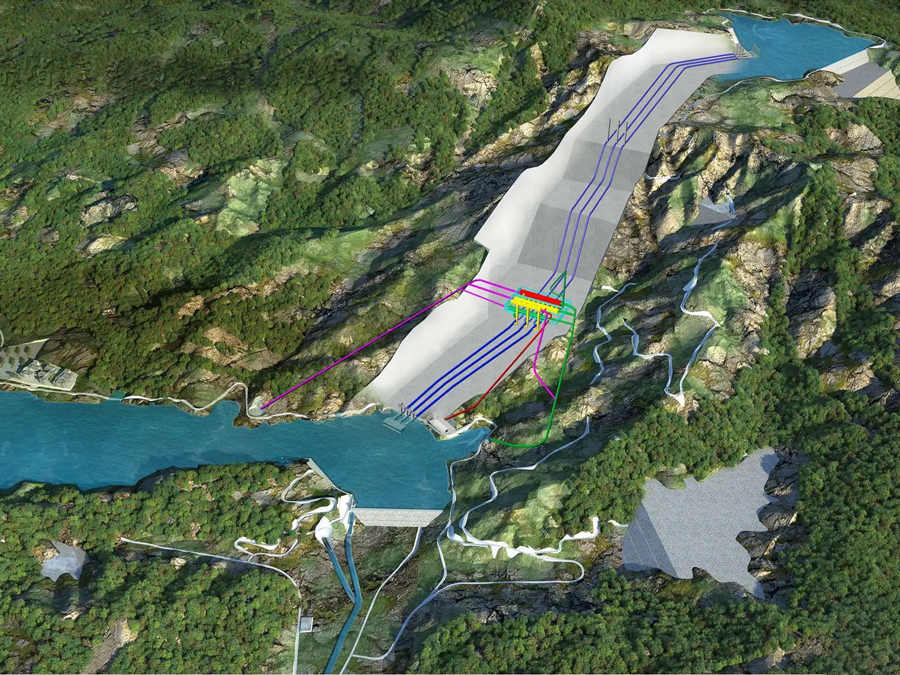Нерӯгоҳи барқи обии обкашӣ технологияи аз ҳама васеъ истифодашаванда ва пухтарасида дар нигоҳдории бузурги энергия мебошад ва иқтидори муқарраршудаи нерӯгоҳ метавонад ба сатҳи гигаватт бирасад. Дар айни замой станциям электрикии обкашй бо микьёси тараккиёташ дар чахон пухтарасида мебошад.
Нерӯгоҳи барқи обии обкаш дорои технологияи баркамол ва устувор ва фоидаи баланди ҳамаҷониба мебошад. Он аксар вақт барои риштарошӣ ва интизорӣ истифода мешавад. Нерӯгоҳи барқи обии обкашӣ технологияи аз ҳама васеъ истифодашаванда ва пухтарасида дар нигоҳдории бузурги энергия мебошад ва иқтидори муқарраршудаи нерӯгоҳ метавонад ба сатҳи гигаватт бирасад.
Тибқи омори нопурраи Кумитаи нигаҳдории энержии Ассотсиатсияи Тадқиқоти Энергетикии Чин, дар ҳоли ҳозир як нерӯгоҳи обкашӣ бо рушди пешрафтатарин ва бузургтарин иқтидори насбшуда дар ҷаҳон нерӯгоҳи обкашӣ мебошад. То соли 2019 иқтидори ҷаҳонии нигоҳдории нерӯи барқ ба 180 миллион кВт ва иқтидори муқарраршудаи нерӯгоҳҳои обкашӣ аз 170 миллион кВт гузашт, ки 94%-и захираи умумии энергияи ҷаҳониро ташкил медиҳад.
Нерӯгоҳи барқи обии обкашӣ қувваи барқро дар сарбории ками системаи энергетикӣ истифода мебарад, то обро ба ҷои баланд барои нигоҳдорӣ интиқол диҳад ва обро барои тавлиди нерӯи барқ дар давраи сарбории баланд холӣ кунад. Дар вацти кам будани сарборй станцияи обии обкашй истифодабаранда мебошад; Дар авҷи сарборӣ, он як нерӯгоҳи барқ аст.
Агрегати ГЭС-и обкаш ду вазифаи асосй дорад: обкашй ва тавлиди энергия. Агрегат дамчун турбинаи гидравликй дар вадти сербориши системаи энергетикй кор мекунад. Кушодани венти роҳнамоии турбинаи гидравликӣ тавассути системаи губернаторӣ барои табдил додани энергияи потенсиалии об ба энергияи механикии гардиши агрегатҳо танзим карда мешавад ва сипас энергияи механикӣ ба воситаи генератор ба энергияи электрикӣ табдил дода мешавад;
Вақте ки бори системаи энергетикӣ кам аст, он ҳамчун насоси об барои кор истифода мешавад. Энергияи электр дар нуқтаи паст барои обкашӣ аз обанбори поёнӣ ба обанбори боло истифода мешавад. Тавассути танзими автоматии системаи губернатор, кушодани қуттии роҳнамо мувофиқи сари насос ба таври худкор танзим карда мешавад ва энергияи барқ ба энергияи потенсиалии об барои нигоҳдорӣ табдил меёбад.
Нерӯгоҳи барқи обии насосӣ асосан барои риштарошӣ, модуляцияи басомадҳо, ҳолати фавқулодда ва оғози сиёҳи системаи энергетикӣ масъул аст, ки метавонад бори системаи энергетикиро беҳтар ва мувозинат кунад, сифати таъминоти барқ ва манфиатҳои иқтисодии системаи энергетикиро беҳтар созад ва сутуни таъмини кори бехатар, иқтисодӣ ва устувори шабакаи барқ мебошад. Нерӯгоҳи барқи обии обкашӣ дар кори бехатари шабакаҳои барқӣ бо номи «стабилизатор», «регулятор» ва «балансер» маъруф аст.
Тамоюли рушди нерӯгоҳҳои обии обкашӣ дар ҷаҳон иқтидори баланд, иқтидори калон ва суръати баланд мебошад. Сатҳи баланди об маънои онро дорад, ки агрегат ба сатҳи баландтари об рушд мекунад. Иқтидори калон маънои онро дорад, ки иқтидори як агрегат меафзояд. Суръати баланд маънои онро дорад, ки агрегат суръати баландтари мушаххасро қабул мекунад.
Сохтор ва хусусиятҳо
Биноҳои асосии Нерӯгоҳи барқи обии обкашӣ умуман обанбори болоӣ, обанбори поёнӣ, системаи интиқоли об, нерӯгоҳи барқӣ ва дигар биноҳои махсусро дар бар мегиранд. Нисбат ба станцияхои электрикии обии мукаррарй иншоотхои гидротехникии станцияхои электрикии обии обкаш дорои характеристикахои асосии зерин мебошанд:
Ду обанбор вуҷуд дорад. Назар ба станцияхои электрикии обии мукаррарии иктидори якхела иктидори обанборхои станцияхои электрикии обии обкаш одатан хурд аст.
Сатхи оби обанбор хеле тагьир ёфта, зуд-зуд пасту баланд мешавад. Барои иҷрои вазифаи риштарошӣ ва пур кардани водиҳо дар шабакаи барқ, диапазони ҳаррӯзаи сатҳи оби обанбор дар Нерӯгоҳи барқи обии обкашӣ одатан калон аст, одатан зиёда аз 10 ~ 20 м ва баъзе нерӯгоҳҳои обӣ ба 30 ~ 40 метр мерасад ва суръати тағирёбии сатҳи оби обанбор ҳатто то 8 ~ 5 соат, 10м / соат.
Талаботи зидди обанбор баланд аст. Агар ГЭС-и соф аз обанбори боло рехта бошад, бисьёр обро талаф дихад, истехсоли кувваи станцияи электрики кам мешавад. Аз ин ру, талаботи зидди обанбор баланд аст. Дар баробари ин, бо мақсади пешгирии бад шудани шароити гидрогеологии минтақаи лоиҳавӣ, вайроншавии сел ва резиши концентратӣ, ки дар натиҷаи резиши об ба вуҷуд омадаанд, инчунин оид ба пешгирии резиши обанбор талаботи баландтар гузошта шудааст.
Сари об баланд аст. Сари оби Нерӯгоҳи барқи обии обкашӣ одатан баланд аст, асосан 200 ~ 800 м. Нерӯгоҳи обии обкашии Ҷиси бо иқтидори умумии муқарраршуда 1,8 миллион кВт аввалин лоиҳаи қисмати сарпӯши 650 метр дар Чин ва Нерӯгоҳи барқи обии насосии Дунхуа бо иқтидори умумии насбшуда 1,4 миллион кВт аввалин лоиҳаи қисмати сарпӯши 700 метр дар Чин мебошад. Дар баробари инкишофи пай дар паи дарачаи техникии станцияхои электрикии обии обкаш дар Хитой шумораи станцияхои электрикии обии пуриктидор ва иктидори калон торафт зиёд мешавад.
Баландии насби агрегат паст аст. Барои рафъи таъсири оббозӣ ва обкашӣ ба нерӯгоҳ дар солҳои охир стансияҳои бузурги обкашӣ дар дохили кишвар ва хориҷи кишвар асосан шакли нерӯгоҳи зеризаминиро қабул мекунанд.
Вақти фиристодан: апрел-25-2022

